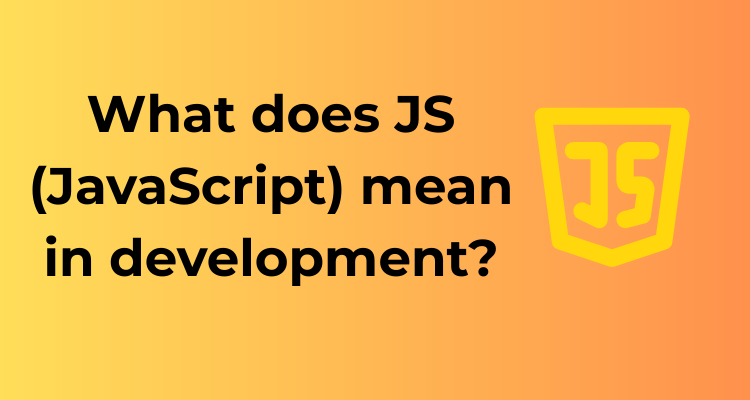JavaScript—better known as JS—is often a term tossed around in the tech world, but what does it really mean? More than just a trendy word in web development, JS is the lifeblood of interactive, dynamic websites. Let’s break it down in a way that resonates with beginners, enthusiasts, and seasoned developers alike.
JavaScript is a powerful programming language that’s primarily used to enhance the interactivity of a webpage. But let’s not confuse it with Java—they’re entirely different beasts (despite the similar names). JS allows websites to do amazing things like updating content dynamically, animating elements, and creating rich media experiences. Think of it like the engine room of online functionality: behind every smooth interaction, JavaScript is hard at work.
Why the Buzz?

Okay, so why is JS all the rage? For starters, it’s everywhere. It’s the universal language of browsers, making it indispensable for web development. Ever clicked a “Read More” button and watched text appear instantly without refreshing the page? That’s JavaScript magic in action! This blend of versatility and reliability is what keeps JS at the top of its game.
Breaking Down Common Uses
- Dynamic Updates: JS updates data on a webpage without requiring a full reload. Great for live sports scores or stock values.
- User Interactions: From dropdown menus to animations to form submissions, JS creates a seamless flow.
- Web Apps: Popular platforms like Gmail, Netflix, and even this page you’re reading wouldn’t be as intuitive without JS!
Accessibility for All
One of the best things about JS is its accessibility. You don’t need to be a coding wizard to start experimenting with it. Many beginners get their start with JavaScript because it’s relatively easy to learn, especially with resources like coding tutorials, interactive sandbox tools, and a massive online community ready to help.
Pro Tips for New JS Learners
- Start Small: Begin with basic scripts, like hiding/showing elements on a webpage.
- Practice: Apply what you learn by building simple projects, such as a to-do list app or interactive quiz.
- Explore Free Resources: Websites like MDN Web Docs and freeCodeCamp are fantastic for both beginners and advanced developers.
- Learn by Debugging: JS errors (trust us, there will be plenty) are your best teacher. Use browser DevTools to understand what’s happening when things don’t work as planned.
The Evolution Timeline of JS: From Netscape to Modern Web Applications
Hello there! Buckle up because we’re diving into an exciting journey through the fascinating history of JavaScript (or JS, if you like it short and sweet). If you’ve ever wondered how this magical language took over the web, you’re in for a treat. Let’s rewind and explore JS’s evolution from its modest beginnings at Netscape to its role as a hero in modern web development.
The Humble Beginning of JavaScript
In 1995, Brendan Eich, a programmer at Netscape Communications Corporation, created JavaScript in just ten days! Yes, you read that right – ten days. Initially named “Mocha,” it soon became “LiveScript” before finally settling on JavaScript. Despite the name, it’s unrelated to Java (but hey, marketing strategies). It was initially crafted as a scripting language to help web browsers become more interactive. Think of it as the secret ingredient for creating dynamic websites.
The Browser Wars and Standardization
In the mid-to-late 1990s, browsers like Netscape Navigator and Internet Explorer were locked in what we now call the “Browser Wars.” Both companies wanted their technologies to lead the charge. JavaScript was quickly adopted by Netscape, while Microsoft introduced their version known as JScript. It got ~messy~ with compatibility issues everywhere. But the web needed a hero, so industry leaders came together to standardize JavaScript under the ECMA (European Computer Manufacturers Association). This led to ECMAScript being born in 1997, essentially shaping the JavaScript we know today.
The Rise of Modern Frameworks

Fast-forward a few years, and JavaScript started blossoming as technology advanced. In the 2000s, Ajax came into the picture, allowing websites to load data without refreshing the whole page. Remember how groundbreaking that was? It’s like stepping into a whole new world of faster, more intuitive user experiences. That wasn’t all. As web development kept evolving, we saw the rise of popular JavaScript libraries and frameworks like:
- jQuery: This was a game-changer in simplifying complex JavaScript tasks.
- AngularJS: Google’s baby, which introduced two-way data binding.
- React: A library from Facebook, emphasizing blazing-fast rendering and component-based architecture.
Where JavaScript Stands Today
Today, JavaScript powers nearly all aspects of web development and transcends beyond browsers. With the emergence of technologies like Node.js, JavaScript broke free from being “just a client-side language” to running on servers too. Now, developers can write front-end and back-end code using JavaScript – how cool is that? It has grown into something versatile, widely supported, and vital for building modern apps.
What Makes JS’s Evolution Inspiring?
What’s incredible about JavaScript is its ability to adapt while staying true to its core purpose: interactivity. Despite the emergence of newer technologies, JS remains king because it evolves with developer needs. Frameworks like Vue.js, robust ecosystem tools, and vast community support all emphasize how essential it is. JavaScript has gone from enhancing simple HTML pages to becoming the foundation for apps, games, and even augmented reality.
Key Components That Make JS Stand Out in Web Development
So, you’ve probably heard a lot about JavaScript (let’s call it JS for short). It’s like the superstar of web development, but what really makes it stand out in a sea of programming languages? Let’s get comfortable and unpack its key components that make it so powerful and, honestly, pretty fun to work with.
1. Dynamic Nature: Where JS Comes Alive
Have you ever noticed cool things happening on a webpage—like a button that smoothly transitions color when you hover over it or a page that updates without reloading? That’s all JS magic! Its dynamic nature allows developers to manipulate web elements in real-time. Whether it’s updating content, animating objects, or responding to user interactions, JS thrives at making websites feel alive.
2. Event Handling: Listening and Responding
Think of JS as an excellent listener. It’s built with robust event-handling capabilities, meaning it knows exactly when to respond to what the user does. Did you just click on a button or scroll down a page? JS recognizes those actions (called “events”) and kicks off the appropriate responses, almost like a personal assistant anticipating your needs.
3. JavaScript Engines: The Power Source
Here’s the techy behind-the-scenes part—but don’t worry, it’s not too complicated. JavaScript is able to run at lightning speed today thanks to modern JS engines, like Google Chrome’s V8 Engine. These engines optimize JS code to execute it faster, making your favorite websites incredibly responsive. This is why even the most complex web apps feel so smooth these days!
4. Cross-Platform Versatility: Not Just for Browsers
Wait, you thought JS was only for making websites pretty? Think again! With tools like Node.js, JS has broken out of the browser’s sandbox and now powers backend servers, mobile apps, and even IoT devices. Its versatility is a huge reason why developers love it—why learn multiple languages if you can use one for practically everything?
5. Frameworks and Libraries: Your Productivity Boosters
Working smarter, not harder, is the motto here. JS offers an incredible ecosystem of libraries (hello, jQuery, D3.js) and frameworks (Angular, React, Vue, anyone?) that help developers create applications faster and with fewer headaches. Instead of building everything from scratch, these tools provide pre-made solutions tailored for common scenarios, saving loads of time.
6. Asynchronous Programming: Multi-Tasking Champion
Do you like multitasking? Well, so does JavaScript. Thanks to its asynchronous programming abilities (like Promises and async/await), JS can handle multiple tasks simultaneously. Think fetching data from a server while also keeping the page interactive. No freezing screens here!
7. Easy Learning Curve (Sort Of)
Among programming languages, JS is considered relatively beginner-friendly. Its syntax feels approachable, like a spoken language, making it easier to dive in. That said, you’ll want to stay curious and keep exploring, as this seemingly simple tool packs a ton of depth.
How JS Shapes Interactive User Experiences
Imagine visiting a website that feels static, lifeless, and somewhat dull. Now, compare that to a site bursting with dynamic animations, pop-up notifications, and interactive forms that instantly alert you if something is missing! That’s where JavaScript (JS) truly shines—as the magical engine behind immersive and engaging online experiences.
Creating Dynamic Content
At its core, JavaScript is what allows content on a webpage to change without needing a full-page reload. For example, think about when you use an email platform and see new messages pop into your inbox without refreshing the page. JS listens, updates, and displays real-time results seamlessly—making websites super responsive.
This isn’t just nice to have; it’s often the expectation these days. Users want instant gratification, and interactive content keeps them hooked instead of clicking away. If you’ve heard the term “dynamic websites”, know that JavaScript is usually behind the curtain making that magic happen.
Interactive Forms and Validations
Ever started filling out a form online and mistyped your email? Instead of letting you submit it only to get an error later, JavaScript steps in to validate your input instantly. The browser might flash a friendly “Please enter a valid email address” message right next to the field. Simple, right?
These small interactions do more than make our lives easier—they save us time and reduce frustration. Businesses understand that a smooth and error-free form can be the difference between a completed purchase and an abandoned cart. Thank JS for smoothing the online checkout process!
Adding Animation and Motion
What’s more fun than a website that literally moves you? JavaScript powers animations and effects that bring digital experiences to life. Whether it’s a button that changes color when hovered over, a playful loading spinner, or even full-on animations telling a story, JS delivers the wow factor.
These lively elements not only draw attention but also serve a purpose! For example, animations can guide the user’s eye to an important feature—like highlighting a discount code field—or convey feedback, like showing progress while files are uploading. They keep websites feeling natural, intuitive, and even joyful to use.
Single Page Applications (SPAs)
Do you enjoy platforms like Gmail, Twitter, or Spotify’s web player? Many of these are Single Page Applications, made possible by JavaScript frameworks like React, Vue, or Angular. Instead of loading new pages as you navigate, SPAs dynamically update the content within a single page, giving you a swift and smooth user experience.
This is especially handy in delivering app-like experiences for web platforms. With SPAs, transitions are quicker, usability improves, and users stay more engaged since there’s less waiting around.
Personalization and User Preferences
Ever logged back into a website, and it remembered your preferences—whether it was your favorite theme, saved location, or wishlist items? JavaScript handles much of this personalization magic by storing data like cookies or utilizing browser features for local storage. It makes users feel more “at home” instantly.
Why Does It Matter?
At the end of the day, we live in a digital age where attention spans are fleeting. Websites and apps that only present static content risk losing users’ interest quickly. By integrating JS-powered interactivity, developers help websites evolve into dynamic, fun, and highly engaging experiences—whether it’s a simple animation or a full-blown real-time app.
Common Misconceptions and Myths About JS
JavaScript, or JS for short, has become one of the most popular programming languages on the planet. But, with popularity comes a flurry of assumptions that aren’t always accurate. Whether you’re new to coding or an experienced web developer, chances are you’ve come across some of these common myths. Let’s debunk them together, one by one!
1. It’s Just for Front-End Developmen
If you’ve heard this one before, it’s easy to see why! After all, JavaScript was originally created to enhance front-end user interaction. However, with the introduction of Node.js, JavaScript has evolved to dominate the back-end space too. Now, developers can write server-side code, create APIs, and even power apps entirely with JS. In fact, many full-stack developers love JavaScript because it allows them to use the same language across all layers of development. It’s not just about fancy UI animations anymore.
2. JavaScript Is Not a Real Programming Language
Ah, the age-old myth. Some folks might believe that JavaScript isn’t as “serious” or “real” as compiled languages like C++ or Java. But let us tell you—this couldn’t be further from the truth. JavaScript is a powerful, versatile language that’s capable of creating incredibly complex applications. Everything from Netflix to PayPal to your favorite social networking platforms uses JavaScript in some form. Trust us, it’s very real, and very impactful.
3. JavaScript Is the Same as Java
Let’s put this rumor to rest: JavaScript is not Java. Despite the similar-sounding names, the two languages share little in common. The confusion stems from the fact that JavaScript was named during a time when Java was gaining popularity, as a marketing tactic. While Java is a strictly object-oriented programming language, JavaScript is a lightweight, interpreted language designed for enhancing web pages dynamically. Think apples and oranges—they’re different, but they both belong on the programming fruit tray.
4. You Don’t Need to Learn JavaScript in Today’s Web Development
With the rise of drag-and-drop website builders, frameworks, and no-code platforms, it’s easy to think that learning JavaScript is unnecessary. But here’s the truth: JavaScript powers the modern web. Most popular frameworks like React, Angular, and Vue.js are built on JavaScript. It’s the backbone of interactive features, and without it, the web would be painfully static. If you want to level up as a developer, JS remains a must-have tool in your kit.
5. JavaScript Is Slow
There was a time when JavaScript was criticized for being slower than other languages, but times have changed. With runtime environments like V8 (used in Node.js) and Just-In-Time (JIT) compilation, JavaScript now competes with some of the fastest programming languages. Got performance concerns? Writing clean code and using best practices can make your JS applications blazing fast.
6. It’s Too Difficult to Learn
If you’ve been told that JavaScript is overly complex, don’t let that scare you! While every language has its quirks, JS has a fairly low entry barrier compared to many others. There are countless free resources, tutorials, and interactive platforms to help you master it. And let’s not forget about the massive and supportive JavaScript community online—you’re never alone on your learning journey.
Real-World Use Cases Where JS Dominates
JavaScript (JS) isn’t just a flashy tool for making buttons pop or colors change on a website – although it’s great at that too. It is genuinely the backbone of countless real-world applications that we use daily. Let’s dive into some of these practical, impactful use cases where JS takes center stage. You might just be surprised how much of your digital world is powered by this incredible language!
1. Creating Dynamic Websites and Portals
Ever been to a website that felt interactive, intuitive, and almost alive? Behind all the smooth dropdown menus, real-time form validations, and personalized recommendations, there’s a mighty presence of JS. Platforms like Google Maps use it extensively to enable seamless panning and zooming, delivering data dynamically without the need to refresh the entire page.
The magic of JavaScript frameworks like React, Vue.js, and Angular ensures dynamic user interfaces that can adapt instantly based on user interactions. These frameworks are the secret sauce behind some of the sleekest, most polished websites you encounter each day.
2. Developing Robust Web Applications
JavaScript isn’t limited to improving website aesthetics—it powers full-fledged web applications. For example, tools like Trello or Slack rely on JS to provide real-time collaboration among users. Using backend technologies like Node.js, developers can create server-side functionalities that make these apps both fast and scalable.
With JS driving the ship, web applications are no longer limited to content delivery—they’ve become interactive platforms for productivity and communication.
3. Gaming: Yes, in Your Browser!
Gaming isn’t just for console lovers anymore. With engines like Phaser and Three.js, developers can build 2D or even immersive 3D games directly in a browser. Ever stumbled upon addictive web games like Agar.io? That’s JS flexing its muscle to deliver gaming experiences without requiring a big download or a fancy graphics card.
The added boon? With the rapid advancements in WebGL and HTML5, JS has the power to transform browsers into gaming machines, bridging the gap between casual gamers and developers in new and exciting ways.
4. Mobile Applications Powered by Hybrid Frameworks
Sure, creating apps sounds like a job for Java or Swift, but JavaScript has barged into the mobile development scene and is refusing to leave. Frameworks like React Native and Ionic allow developers to create cross-platform mobile apps using JS. Popular apps like Instagram and Airbnb harness React Native to ensure seamless user experiences on both iOS and Android.
By writing code once and deploying it across platforms, JavaScript clears the path for rapid and resource-efficient app development.
5. Data Visualization and Analytics
Data is everywhere, and making sense of it is easier with JS! Libraries like D3.js and Chart.js allow developers to create charts, graphs, and dynamic dashboards that are user-friendly and visually pleasing. Whether it’s tracking sales performance or analyzing user engagement trends, JavaScript simplifies how data is visualized and understood.
Fun fact: Ever used Google Analytics? Its real-time reporting involves JavaScript to track user behavior across websites.
6. Building the Future: IoT and AI-powered Applications
The Internet of Things (IoT) isn’t just science fiction anymore. JavaScript is finding its way into programming devices like smart thermostats or home assistants. Node.js, for example, allows developers to manage multiple connected devices efficiently. Meanwhile, libraries like TensorFlow.js are introducing AI and machine learning capabilities directly into browsers with JS.
Imagine controlling an entire smart home setup or running a face recognition system, all crafted with JavaScript. Isn’t that incredible?
Comparing JS with Other Programming Languages: Spotting the Differences
Ah, JavaScript (or JS, as we affectionately call it)! It’s the life of the web party and the spice that turns bland web pages into dynamic experiences. But how does it stack up against other programming languages? If you’ve ever been curious about this, you’ve come to the right place. Let’s break it all down in plain English. Ready? Let’s dive in!
1. The Language of the Web vs. the Rest of the Pack
Let’s start with an obvious one. Some programming languages specialize in various scopes like mobile apps (Swift, Kotlin) or systems programming (C, Rust). But JavaScript? It reigns supreme as the king of web interactivity. Contrary to many other languages, JS runs natively in your browser, meaning no special setup is needed. Just pop open a console in your web browser, and voilà—you’re ready to start coding.
- Runs Everywhere: JS is the de-facto language for browsers thanks to its compatibility with all major ones (yes, even Internet Explorer back in the day).
- Interactivity is Its Forte: Unlike Python or Java, JS’s main job is interactivity. It’s what enables those fancy image sliders, dynamic forms, and real-time chat apps.
2. Compiled vs. Interpreted: JS Plays by Its Own Rules
Languages like C++ are compiled before running, meaning you write code, turn it into a machine-readable file, then execute it. But JavaScript is an interpreted language, processed line-by-line by the browser without the need for compilation. This makes it remarkably flexible and easy to get started with.
Basically, JavaScript enables a *write-then-run-immediately* environment, great for creative prototyping and rapid development. Sure, this can lead to performance bottlenecks for very resource-heavy applications, but for most web tasks, it’s a dream come true!
3. An Untyped Approach? Yes, Please (and No, Thank You)
Here’s a quirky feature: JavaScript is loosely typed, meaning you don’t need to explicitly declare variable types like you would in Java or C#. You can go ahead and write:
let age = 29; age = "Twenty-nine";
“Wait, what just happened?” In JS, the interpreter just shrugs and lets you do it—that’s what! While some developers love this for its simplicity, others point out that strong typing (as found in TypeScript) prevents errors. It really depends on what you need.
4. Asynchronous Adventures with JavaScript
One area where JavaScript truly stands out is its ability to handle asynchronous tasks efficiently. Thanks to concepts like callbacks, Promises, and async/await, it solves real-world problems like fetching data from APIs or running tasks in the background.
Compare that to Python or Ruby, where asynchronous programming takes a bit more setup, and you’ll start seeing why frameworks like Node.js use JavaScript to manage high-traffic server-side scenarios.
5. Ecosystem: A World of Libraries, Frameworks, and Tools
Let’s not forget about the vibrant and gigantic JS ecosystem. No language beats the sheer number of useful libraries and frameworks designed for JavaScript. Whether it’s React for building user interfaces, D3 for stunning visualizations, or TensorFlow.js for machine learning, JavaScript seems to have something for everyone.
- Compare This: While languages like Java or PHP serve very specific needs, JavaScript can traverse client-side, server-side (thanks to Node.js), and emerging fields like IoT or AI.
- Instant Gratification: The npm (Node Package Manager) repository is one of the largest in the coding universe, making it easy for JS developers to pick, mix, and use tools quickly.









